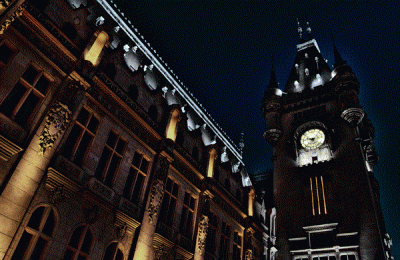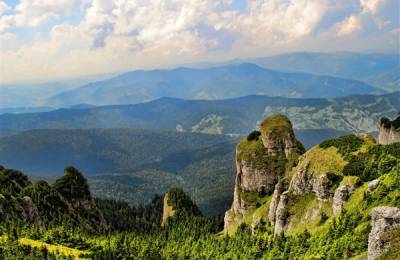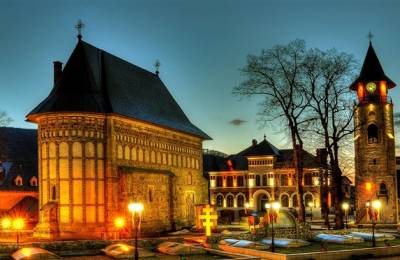Description
With thickly forested hills and tranquil valleys undulating off into the horizon, Moldavia mixes the rich folklore, beauty and turbulent history of Transylvania and the quietly appealing, bucolic paradise of Maramures into its own fusion of the best of Romania. Cavort through the countryside on horse-drawn carts, stopping to gawk at the world-famous medieval painted monasteries. Hike or ski over eye-popping mountain terrain. Then urbanize in Iasi and Suceava, where the first generation to have no vivid memories of Ceausescu is rapidly developing a taste for fine food, shopping and late-night indulgence.
In 1359, under Prince Bogdan of Cuhea, Moldavia became the second Romanian principality to divorce itself from the Hungarians. During the 18th century the region served as a refuge for thousands fleeing persecution in Hungarian-ruled Transylvania. Stefan cel Mare (Stephen the Great) and his son Petru Rares erected fortified monasteries and churches throughout Bucovina, many of which have survived centuries of war and enjoy UNESCO World Heritage status. Mired under Turkish rule after Petru Rares’ defeat in 1538, Moldavia was finally united with Wallachia by Alexandru Ioan Cuza in 1859. Almost immediate cultural and economic growth followed and the modern Romanian state was born, with Iasi as its capital.
Moldavia used to be much larger. Bessarabia, the area east of the Prut River, was annexed by Russia in 1812. Despite being recovered from 1918 to 1940 and again from 1941 to 1944, Bessarabia is now split between Ukraine and the Republic of Moldavia. Northern Bucovina is now in southwestern Ukraine.
Romanians refer to Moldavia as ‘Moldavia’ (the Slavic form of Moldavia), a Stalinist legacy and point of confusion for visitors. Neighboring Moldavia is referred to as the ‘Republic of Moldavia’.
Attractions
Iasi
Iasi is the city on seven hills, is the second Romanian city after Bucharest in terms of population. Its history goes back to ancient times, when it was an important commercial centre. During the XVI century, Iasi became the capital of Moldovia, then the capital of the United Romanian Principalities (in XIX century, together with Bucharest) and the capital of Romania for two years during the First World War. Now, Iasi is best known especially as a cultural center and university city.
The main attractions of the city are: the Palace of Culture (built on the ruins of the medieval Voivodal Court of Moldavia in a neo-gothic style, today the home of History Museum, Ethnographic Museum, Art Museum and Science and Technical Museum), Saint Nicholas Church (the oldest surviving church in Iasi), Three Hierarchs Church, the Metropolitan Cathedral where are the relics of Saint Parascheva brought from Constantinople, the Great Synagogue (the oldest Mosaic religion edifice in Romania), Copou Garden (with his Obelisk of Lions – the oldest Romanian monument) Dosoftei House and Creanga’s Hovel (the fist memorial house in Romania).
Neamt Citadel
Close to the city of Tirgu Neamt is the Neamt Citadel, a really impressive medieval citadel which was present in the events of primary importance that Moldova took part of.
The citadel’s plan has the shape of a quadrangle with unequal sides, adapted after the field. Specific to the Neamt Citadel is the fact that the defensive towers from the four corners were not placed outside the walls like the citadels which were built during the same period. The gothic style especially is visible at the gates and the windows borders and for the construction it was used mostly river stones.
Over two centuries, the citadel had a very important politic and military role, and starting with the middle of the XIX century, Neamt Citadel became a symbol of the history of Romanian people.
Inside the citadel, can be visited Privacy Room, the Weapons Hall where shields and spears can be admired and visitors can learn about the armaments and the military tactics, the Provisions Room and the Kitchen, the dark and cold jail which present four villains tied in chains, with long and untidy beards, long shirts and straw on the floor, the Chapel Saint Nicolas and the Ladies Room where can be admired clothes of the voivodes’ wives.
Neamt Monastery
One of the oldest monasteries in the Romanian region of Moldova, dating back in the XIV century, the Neamt Monastery represents a central point for knowing the spirituality character of the area.
Also called the “Jerusalem of Romanian Orthodoxy”, the monastery is the most interesting and representative monument of the architecture of that time, both in terms of the plan and interior structure, and of the manner of decorating the facades.
From among the monastery’s attractions, the circular Holy Water Recipient from the front of the Neamt Monastery, the miracle-maker icon of the Mother of God, painted in 665 in Israel, which the Moldovian ruler Alexander the Good received as a gift from the Byzantine Emperor John VIII Paleologul, the oldest monastic library whit 18.00 volumes, severals icons from the XVII-XVIII centuries and icons made by famous painter Nicolae Grigorescu.
Ion Creanga Memorial Museum
Well-known for his mastery in rendering fairy tales, tales and stories, Ion Creanga is thought to be one of the classics of the Romanian literature, especially due to his autobiographic masterpiece “Memories of my childhood”.
The “Ion Creanga” Memorial House from Humulesti tells, without words, about the real life of a family from a Moldovian village. Here, the simplicity blends with beauty, from the courtyard hedged with a wicker fence, to the nice interior painted in white, like a childhood dream.
Cucuteni Archaeologic Site
This place was named by the famous Neolithic artifacts that have been found here. Cucuteni Archeological Museum represents one of the most impressive museum in Romania. Placed on top of the Gosan Hill, the museum is a true archeological site with excavations, layers, fragments of walls and foundations, in a hole that descends a few meters long. There are impressive painted ceramics of Cucuteni culture, along with the remains of the settlement there, coexisting with the remains of Geto-Dacian settlement that followed and have left a royal treasure and a decorated tomb.
A church from 1804 and five springs of sulfurous water which can be used in the treatment of various diseases completes this cultural treasure.
Bicaz Gorge
Gorgeous winding roads outlined in the mountains limestone, rocky massifs of an overwhelming beauty, absolutely splendid caves hidden between the limestone walls of the rocks, special flora and fauna, streams with clear cold water and beautiful landscapes, all this you can find in Bicaz Gorge, which represents the connection between Transylvania and Moldovia.
The gorge is a wonderful area that you do not have to miss, especially because it is accessible by car to any tourist.
Izvorul Muntelui Lake
If you like endless surfaces of water, you need to see "the Bicaz Sea", the Izvorului MUntelui Lake, also know as Bicaz Lake. It is the largest artificial lake of Romania and the most beautiful among the entire necklace of lakes on Bistrita River. Beside the 3.200 hectares of the lake, there are beautiful forests where the fir trees are sometimes mixed with hazel nut trees and other trees, all al them situated in the middle of the Ceahlau Massif.
Nothing can be more beautiful than to watch the lake from the huge dam that surrounds it or from on of the nearby peaks.
Dragos Voda Aurochs Reserve
Dragos Voda reservation is one of the largest in Europe, with a surface of 11.500 hectares. The reservation was founded in 1968 and lies in the commune of Vanatori in Neamt, in the vicinity of Neamt Monastery.
According to the chronicle of the Tirgu Neamt Forestry, the first three specimens: Rarau, Raluca and Roxana, were brought from Poland in 1970.
Besiode the specimens of aurochses, the reservation also includes specimens of Carpathian deer, fallow deer, roebucks, foxes, bears, wolves and species of birds.










